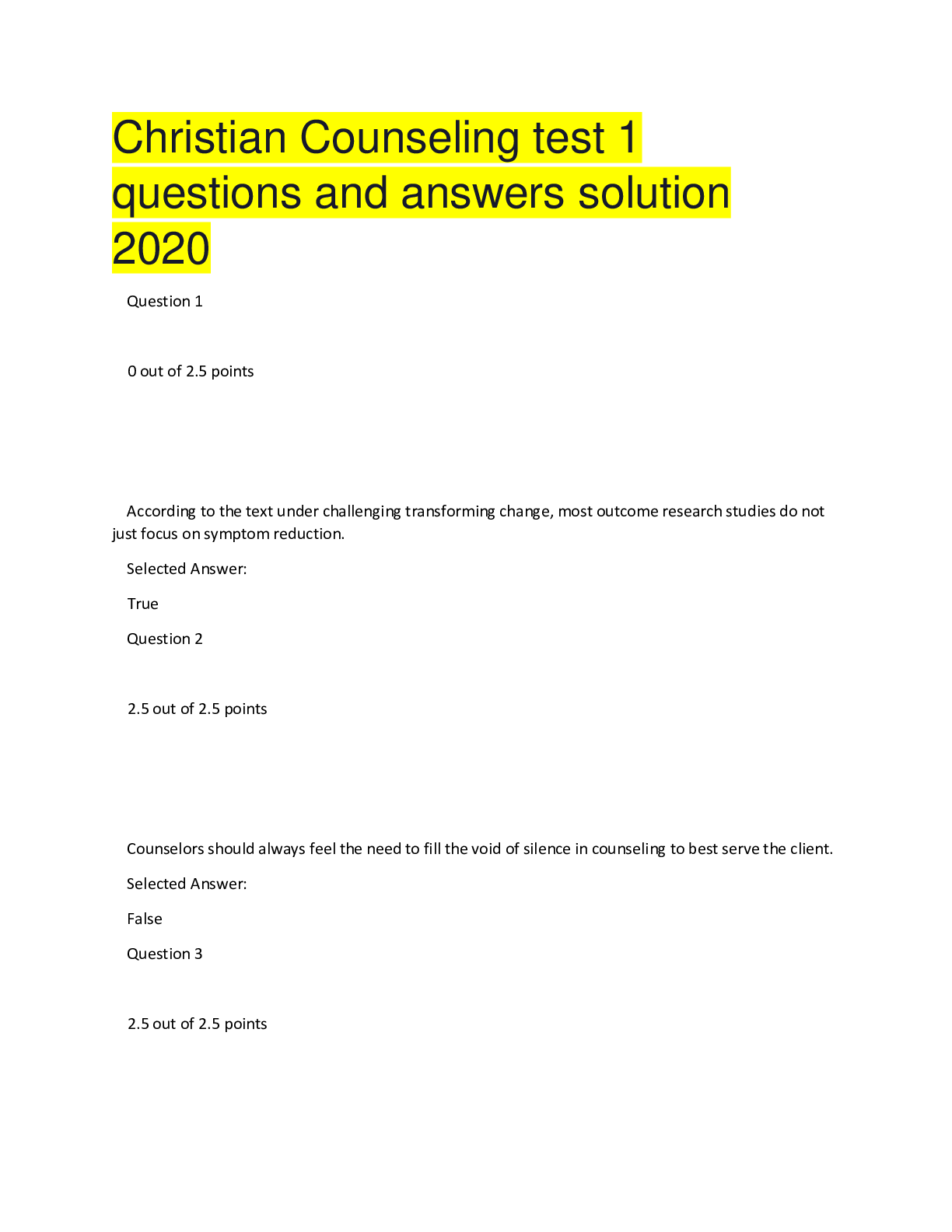*NURSING > QUESTIONS & ANSWERS > Pediatrics Exam 1 Questions and answers, 2022 update, Graded A+ (All)
Pediatrics Exam 1 Questions and answers, 2022 update, Graded A+
Document Content and Description Below
Pediatrics Exam 1 Questions and answers, 2022 update, Graded A+ -Control of movement already acquired -control and organization of processes underlying movement -milliseconds a. motor contr... ol b. motor learning c.motor development - ✔✔a. motor control -acquisition of skill and modification through practice and experience -hours, days, weeks a. motor control b. motor learning c.motor development - ✔✔b. motor learning -age related process of change in motor development -months, years, decades a. motor control b. motor learning c.motor development - ✔✔c. motor development T/F: Most children roll from prone to supine before supine to prone. - ✔✔True What is the correct order of kinesiological development? a. antigravity flexion --> antigravity extension --> physiological flexion b. physiological flexion --> antigravity extension --> antigravity flexion c. physiological flexion --> antigravity flexion --> antigravity extension - ✔✔b. physiological flexion --> antigravity extension --> antigravity flexion Tissue tightness a. structural stability b. positional stability c. internal stability d. external stability - ✔✔a. structural stability Uses body parts to create a large base of support. a. structural stability b. positional stability c. internal stability d. external stability - ✔✔b. positional stability Righting and equilibrium reactions that are already in place. a. structural stability b. positional stability c. internal stability d. external stability - ✔✔c. internal stability Not a phase of development of stability, but occurs when a child does not have any other types of stability but need external support or caregiver to maintain position. a. structural stability b. positional stability c. internal stability d. external stability - ✔✔d. external stability Newborn in physiological flexion with tight flexion. When you sit them up, newborn will stay in tight flexion ball. a. structural stability b. positional stability c. internal stability d. external stability - ✔✔a. structural stability 5 month old putting hands in front of them for prop sitting. a. structural stability b. positional stability c. internal stability d. external stability - ✔✔b. positional stability Older child who stands with legs abducted. a. structural stability b. positional stability c. internal stability d. external stability - ✔✔b. positional stability As infant develops a posture, the size of the BOS will decrease and ROM will increase. a. structural stability b. positional stability c. internal stability d. external stability - ✔✔c. internal stability What is physiological flexion? - ✔✔-hip and knees flexed -ankles in DF -kyphosis posture Which of the following is NOT a normal newborn characteristic? a. physiological flexion b. flexor recoil with passive stretch c. hands tightly fisted d. head in midline e. visually alert f. moves head side to side to clear airway g. head and trunk are linked h. all of the above are true - ✔✔h. all of the above are true What amount of weeks is considered 'premature'? - ✔✔<37 weeks Which is not a premature newborn characteristic? a. decreased physiological flexion b. high muscle tone c. limited ability to self-calm d. can't lift head and neck to clear airway in prone e. immature development of organ systems f. poor feeding skills - ✔✔b. high muscle tone Premature newborns display low muscle tone. What measurements are taken upon birth? - ✔✔-head circumference -abdominal circumference -length -weight What all is assessed upon birth? - ✔✔-APGAR -Measurements -physical exam -gestational assessment T/F: The gestational assessment only looks at physical maturity. - ✔✔False. Also looks at neuromuscular maturity. T/F: The APGAR is taken at 1 minute, 5 minutes, and 10 minutes after birth. - ✔✔False. Just 1 and 5 minutes. T/F: A score of 10 is the best on the APGAR. - ✔✔True What score on the APGAR is defined as 'high risk'? - ✔✔<7 T/F: Scores between 5-7 on the APGAR may indicate less intense resuscitation or supplemental O2 may be necessary. - ✔✔True. T/F: Scores of less than 2 on the APGAR indicate severe asphyxia and definite need for resuscitation. - ✔✔True T/F: The one minute score is highly predictive of change of survival and possible neurological damage. - ✔✔False. The 5 minute score is. APPEARANCE: pale or blue a. 0 b. 1 c. 2 - ✔✔a. 0 APPEARANCE: Body normal color, extremities blue a. 0 b. 1 c. 2 - ✔✔b. 1 APPEARANCE: completely normal color a. 0 b. 1 c. 2 - ✔✔c. 2 PULSE: absent a. 0 b. 1 c. 2 - ✔✔a. 0 PULSE: Below 100 a. 0 b. 1 c. 2 - ✔✔b. 1 PULSE: over 100 BPM a. 0 b. 1 c. 2 - ✔✔c. 2 GRIMACE: no response a. 0 b. 1 c. 2 - ✔✔a. 0 GRIMACE: grimace a. 0 b. 1 c. 2 - ✔✔b. 1 GRIMACE: cry a. 0 b. 1 c. 2 - ✔✔c. 2 ACTIVITY: limp a. 0 b. 1 c. 2 - ✔✔a. 0 ACTIVITY: Some flexion of the extremities a. 0 b. 1 c. 2 - ✔✔b. 1 ACTIVITY: Active motion a. 0 b. 1 c. 2 - ✔✔c. 2 RESPIRATION: absent a. 0 b. 1 c. 2 - ✔✔a. 0 RESPIRATION: Slow, irregular a. 0 b. 1 c. 2 - ✔✔b. 1 RESPIRATION: good, strong cry a. 0 b. 1 c. 2 - ✔✔c. 2 T/F: Neonatal/primitive reflexes are part of intrauterine development and usually appear at the end of the third trimester. - ✔✔False. Appear at end of 2nd trimester. T/F: Neonatal/primitive reflexes are integrated during the first year of life. - ✔✔True. At what age do equilibrium reactions normally appear in prone and supine? - ✔✔4-6 months. At what age are equilibrium reactions considered mature? a. 1-2 years b. 2-4 years c. 3-5 years d. 4-6 years - ✔✔d. 4-6 years What is the correct order of postural control? a. supine --> prone --> SL --> sitting --> quadruped --> kneeling --> standing b. prone --> supine --> SL --> sitting --> quadruped --> kneeling --> standing - ✔✔b. prone --> supine --> SL --> sitting --> quadruped --> kneeling --> standing At what age is there prone postural control? a. 6 months b. 7 months c. 8 months d. 9 months e. 12 months - ✔✔a. 6 months At what age is there supine postural control? a. 6 months b. 7 months c. 8 months d. 9 months e. 12 months - ✔✔b. 7 months At what age is there sitting postural control? a. 6 months b. 7 months c. 8 months d. 9 months e. 12 months - ✔✔c. 8 months At what age is there quadruped postural control? a. 6 months b. 7 months c. 8 months d. 9 months e. 12 months - ✔✔d. 9 months At what age is there standing postural control? a. 6 months b. 7 months c. 8 months d. 9 months e. 12 months - ✔✔e. 12 months GROSS MOTOR MILESTONES: assumes prone on elbows (when placed in prone) a. 2-3 months b. 3-4 months c. 5 months d. 6-7 months e. 8-9 months - ✔✔a. 2-3 months GROSS MOTOR MILESTONES: rolls supine to SL a. 2-3 months b. 3-4 months c. 5 months d. 6-7 months e. 8-9 months - ✔✔b. 3-4 months GROSS MOTOR MILESTONES: pulls to sit without head lag a. 2-3 months b. 3-4 months c. 5 months d. 6-7 months e. 8-9 months - ✔✔c. 5 months GROSS MOTOR MILESTONES: rolls prone to supine a. 2-3 months b. 3-4 months c. 5 months d. 6-7 months e. 8-9 months - ✔✔c. 5 months GROSS MOTOR MILESTONES: feet to mouth a. 2-3 months b. 3-4 months c. 5 months d. 6-7 months e. 8-9 months - ✔✔c. 5 months GROSS MOTOR MILESTONES: self supported sitting propped forward on arms a. 2-3 months b. 3-4 months c. 5 months d. 6-7 months e. 8-9 months - ✔✔c. 5 months GROSS MOTOR MILESTONES: rolls supine to prone a. 2-3 months b. 3-4 months c. 5 months d. 6-7 months e. 8-9 months - ✔✔d. 6-7 months GROSS MOTOR MILESTONES: sits alone without support (hands free) a. 2-3 months b. 3-4 months c. 5 months d. 6-7 months e. 8-9 months - ✔✔d. 6-7 months GROSS MOTOR MILESTONES: sits alone without support (hands free) a. 2-3 months b. 3-4 months c. 5 months d. 6-7 months e. 8-9 months - ✔✔d. 6-7 months GROSS MOTOR MILESTONES: sitting equilibrium: protective extension forward a. 2-3 months b. 3-4 months c. 5 months d. 6-7 months e. 8-9 months - ✔✔d. 6-7 months GROSS MOTOR MILESTONES: transitions quadruped to/from sitting a. 2-3 months b. 3-4 months c. 5 months d. 6-7 months e. 8-9 months - ✔✔d. 6-7 months Closer to 7 Months. GROSS MOTOR MILESTONES: cruises sideways a. 2-3 months b. 3-4 months c. 5 months d. 6-7 months e. 8-9 months - ✔✔e. 8-9 months GROSS MOTOR MILESTONES: sitting equilibrium: protective extension laterally a. 2-3 months b. 3-4 months c. 5 months d. 6-7 months e. 8-9 months - ✔✔e. 8-9 months GROSS MOTOR MILESTONES: Creeps (reciprocal on all fours) a. 2-3 months b. 3-4 months c. 5 months d. 6-7 months e. 8-9 months - ✔✔e. 8-9 months GROSS MOTOR MILESTONES: pulls to stand at furniture a. 2-3 months b. 3-4 months c. 5 months d. 6-7 months e. 8-9 months - ✔✔e. 8-9 months GROSS MOTOR MILESTONES: sitting equilibrium: protective extension backward a. 10-11 months b. 12-15 months c. 16-18 months - ✔✔a. 10-11 months GROSS MOTOR MILESTONES: stands alone for short periods a. 10-11 months b. 12-15 months c. 16-18 months - ✔✔a. 10-11 months GROSS MOTOR MILESTONES: climbs on hands and knees/feet upstairs. a. 10-11 months b. 12-15 months c. 16-18 months - ✔✔a. 10-11 months GROSS MOTOR MILESTONES: walks with 1 HHA a. 10-11 months b. 12-15 months c. 16-18 months - ✔✔a. 10-11 montths GROSS MOTOR MILESTONES: walks independently a. 10-11 months b. 12-15 months c. 16-18 months - ✔✔b. 12-15 months GROSS MOTOR MILESTONES: squats to play and resumes standing in open area. a. 10-11 months b. 12-15 months c. 16-18 months - ✔✔b. 12-15 months GROSS MOTOR MILESTONES: runs "Stiffly" a. 10-11 months b. 12-15 months c. 16-18 months - ✔✔c. 16-18 months GROSS MOTOR MILESTONES: walks up/down stairs holding rail (Step to) a. 10-11 months b. 12-15 months c. 16-18 months - ✔✔c. 16-18 months GROSS MOTOR MILESTONES: walks backwards a. 2-2.5 years b. 3 years c. 4 years d. 5 years - ✔✔a. 2-2.5 years GROSS MOTOR MILESTONES: Walks up and down stairs w/o support (Step to) a. 2-2.5 years b. 3 years c. 4 years d. 5 years - ✔✔a. 2-2.5 years GROSS MOTOR MILESTONES: emerging adult like gait a. 2-2.5 years b. 3 years c. 4 years d. 5 years - ✔✔b. 3 years GROSS MOTOR MILESTONES: jumps with 2 feet together a. 2-2.5 years b. 3 years c. 4 years d. 5 years - ✔✔b. 3 years GROSS MOTOR MILESTONES: able to rise on toes and maintain a. 2-2.5 years b. 3 years c. 4 years d. 5 years - ✔✔b. 3 years GROSS MOTOR MILESTONES: Throws perpendicular to target a. 2-2.5 years b. 3 years c. 4 years d. 5 years - ✔✔b. 3 years GROSS MOTOR MILESTONES: walks up/down stairs w/o support (alternating feet) a. 2-2.5 years b. 3 years c. 4 years d. 5 years - ✔✔c. 4 years GROSS MOTOR MILESTONES: tandem walking a. 2-2.5 years b. 3 years c. 4 years d. 5 years - ✔✔c. 4 years GROSS MOTOR MILESTONES: skipping a. 2-2.5 years b. 3 years c. 4 years d. 5 years - ✔✔d. 5 years GROSS MOTOR MILESTONES: SLS for 10 seconds a. 2-2.5 years b. 3 years c. 4 years d. 5 years - ✔✔d. 5 years GROSS MOTOR MILESTONES: hops 8-10x on one foot a. 2-2.5 years b. 3 years c. 4 years d. 5 years - ✔✔d. 5 years GROSS MOTOR MILESTONES: mature throwing pattern a. 2-2.5 years b. 3 years c. 4 years d. 5 years - ✔✔d. 5 years What is the onset age of rooting, suck, Moro, traction, and planar group reflexes? - ✔✔28 weeks gestation STIMULUS: stroke corner of the mouth, upper lip, and lower lip RESPONSE: movement of the tongue, mouth and head toward the stimulus with opening of the mouth a. rooting b. suck-swallow c. Moro d. traction e. plantar grasp - ✔✔a. rooting What is the purpose of the rooting reflex? - ✔✔allows for searching and locating the feeding source At what age does rooting reflex integrate? - ✔✔3 months STIMULUS: place a finger or nipple inside the infants mouth RESPONSE: lip closure followed by strong rhythmical suck and finally swallow a. rooting b. suck-swallow c. Moro d. traction e. plantar grasp - ✔✔b. suck-swallow What is the purpose of the suck-swallow reflex? - ✔✔Feeding - allow for ingestion of food What age does the suck-swallow reflex integrate? - ✔✔2-5 months STIMULUS: rapidly drop the infants head backwards about 30 deg RESPONSE: -first phase = arm extension/abduction and hand opening -second phase = arm flexion/adduction -often accompanied by crying, shaking, or tremors, a. rooting b. suck-swallow c. Moro d. traction e. plantar grasp - ✔✔c. Moro What is the purpose of the Moro reflex? - ✔✔helps to break up the physiological flexion seen in newborns When does the Moro reflex integrate? - ✔✔5-6 months STIMULUS: Grasp infant's forearm and pull to sit RESPONSE: complete flexion of both UE including a grasp a. rooting b. suck-swallow c. Moro d. traction e. plantar grasp - ✔✔d. traction What is the purpose of the traction reflex? - ✔✔enhances momentary grasp What is the integration age of the traction reflex? - ✔✔2-5 months STIMULUS: apply pressure with your thumb on the ball of the infant's foot RESPONSE: Toe flexion a. rooting b. suck-swallow c. Moro d. traction e. plantar grasp - ✔✔e. plantar grasp What is the purpose of the plantar grasp reflex? - ✔✔Believed to be a phylogenic memory of young animals clinging to their moths. What is the integration age of the plantar grasp reflex? - ✔✔9 months What is the onset age of positive support reflex? - ✔✔35 weeks gestation. What is the onset age of palmar grasp, spontaneous stepping, and asymmetrical tonic neck reflexes? - ✔✔37 weeks gestation STIMULUS: place your index finger in the infants palm from the ulnar side and give pressure to the palm RESPONSE: -phase 1: catching or quick flexion and adduction of the arms -phase 2: holding or reflexive grasp a. palmar grasp b. positive support [Show More]
Last updated: 1 year ago
Preview 1 out of 94 pages
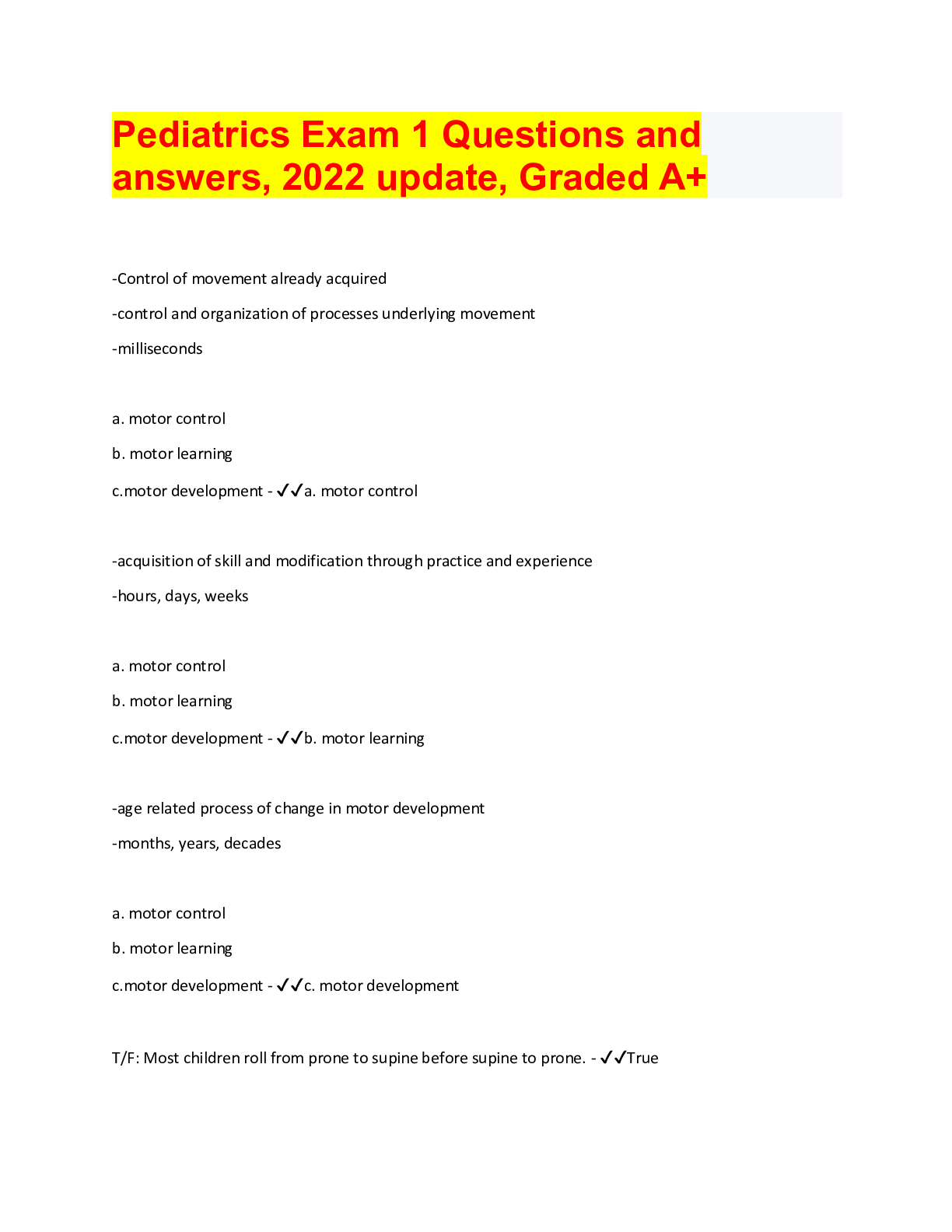
Buy this document to get the full access instantly
Instant Download Access after purchase
Add to cartInstant download
We Accept:

Reviews( 0 )
$12.00
Document information
Connected school, study & course
About the document
Uploaded On
Aug 22, 2022
Number of pages
94
Written in
Additional information
This document has been written for:
Uploaded
Aug 22, 2022
Downloads
0
Views
68













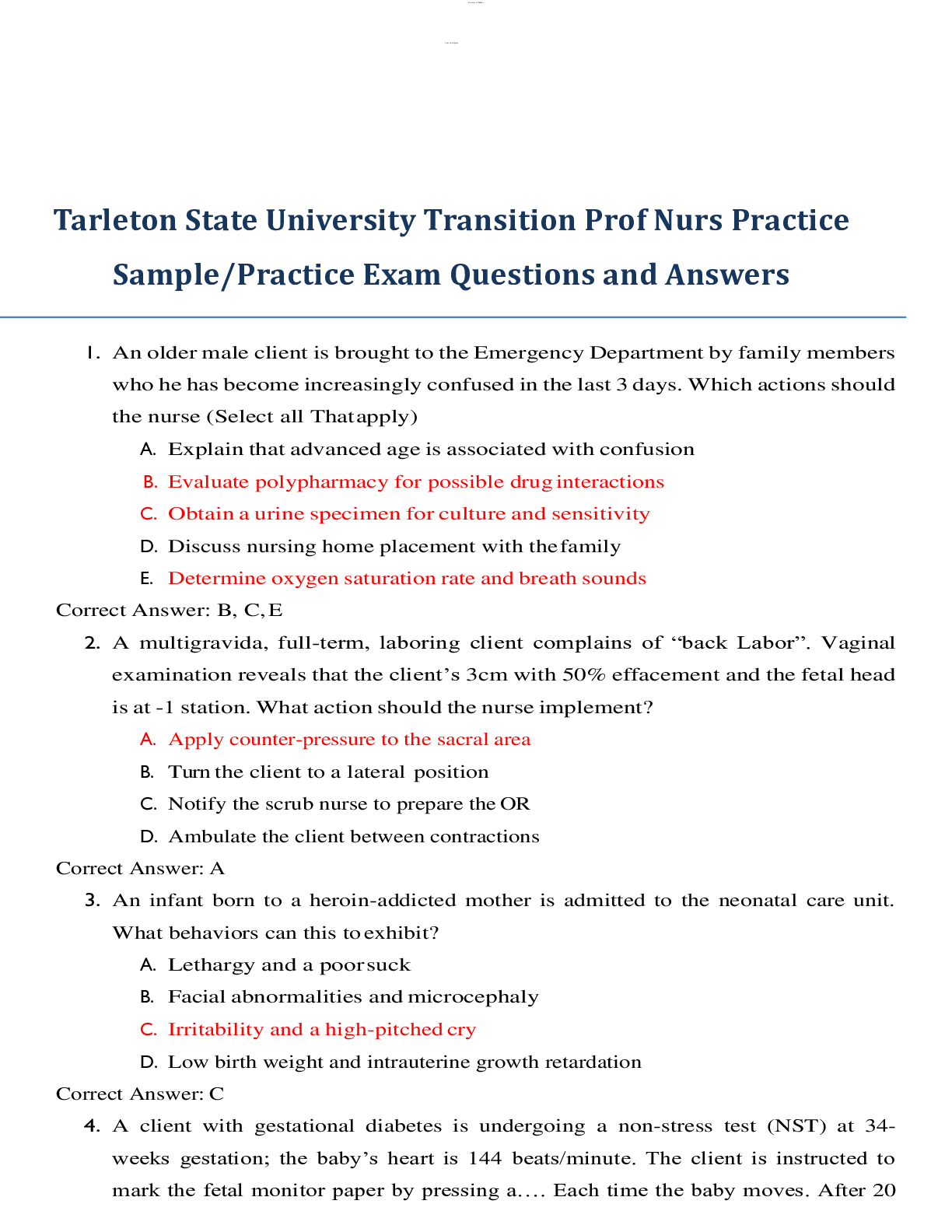


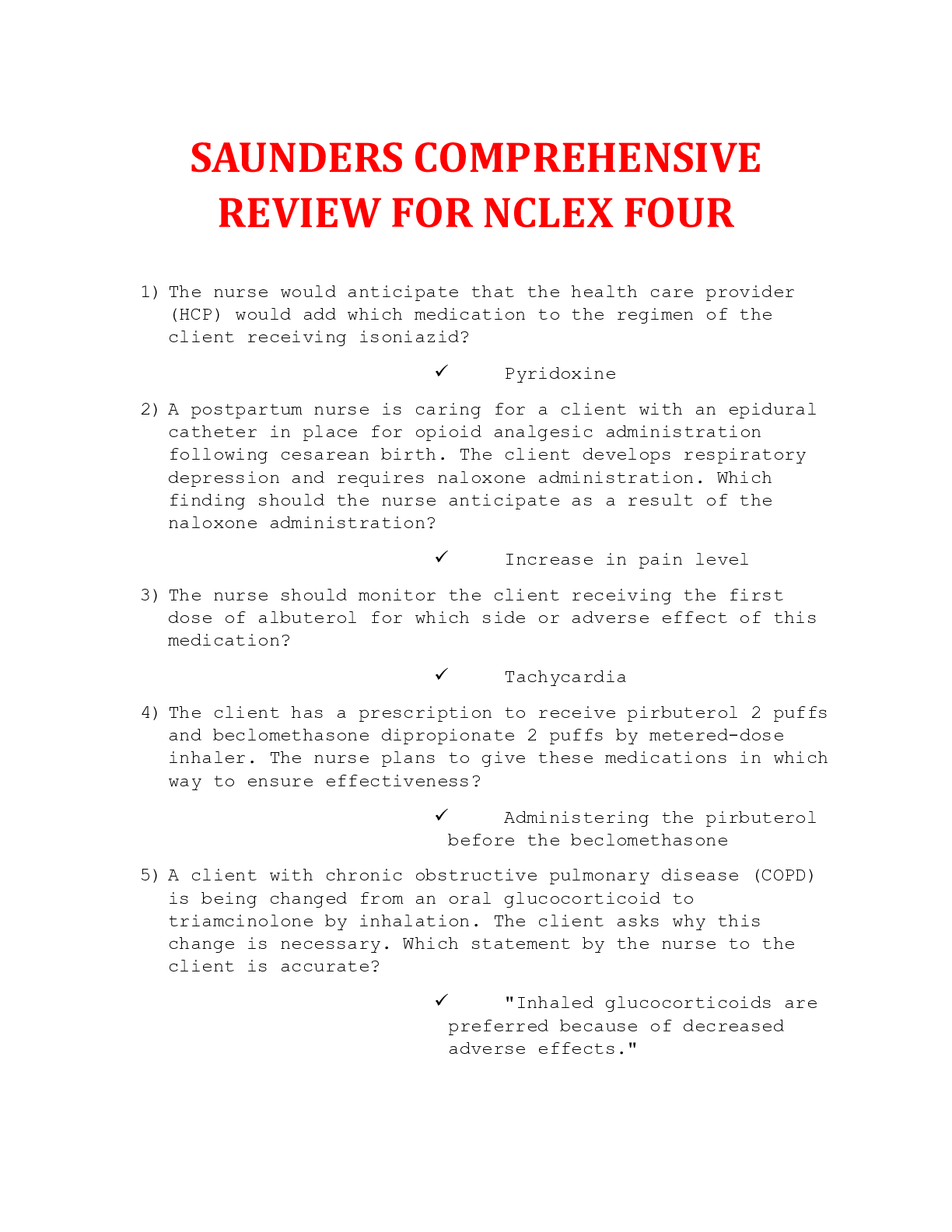
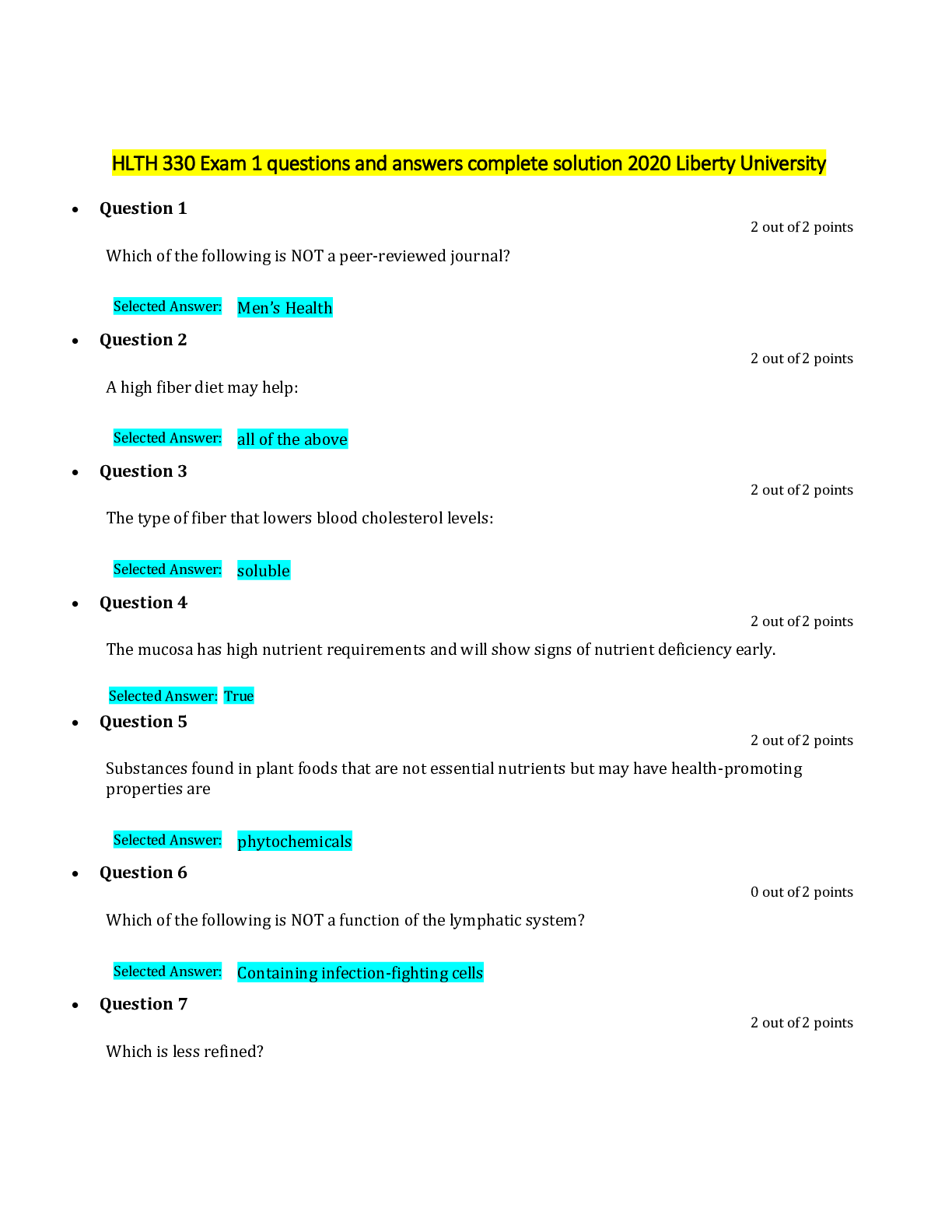
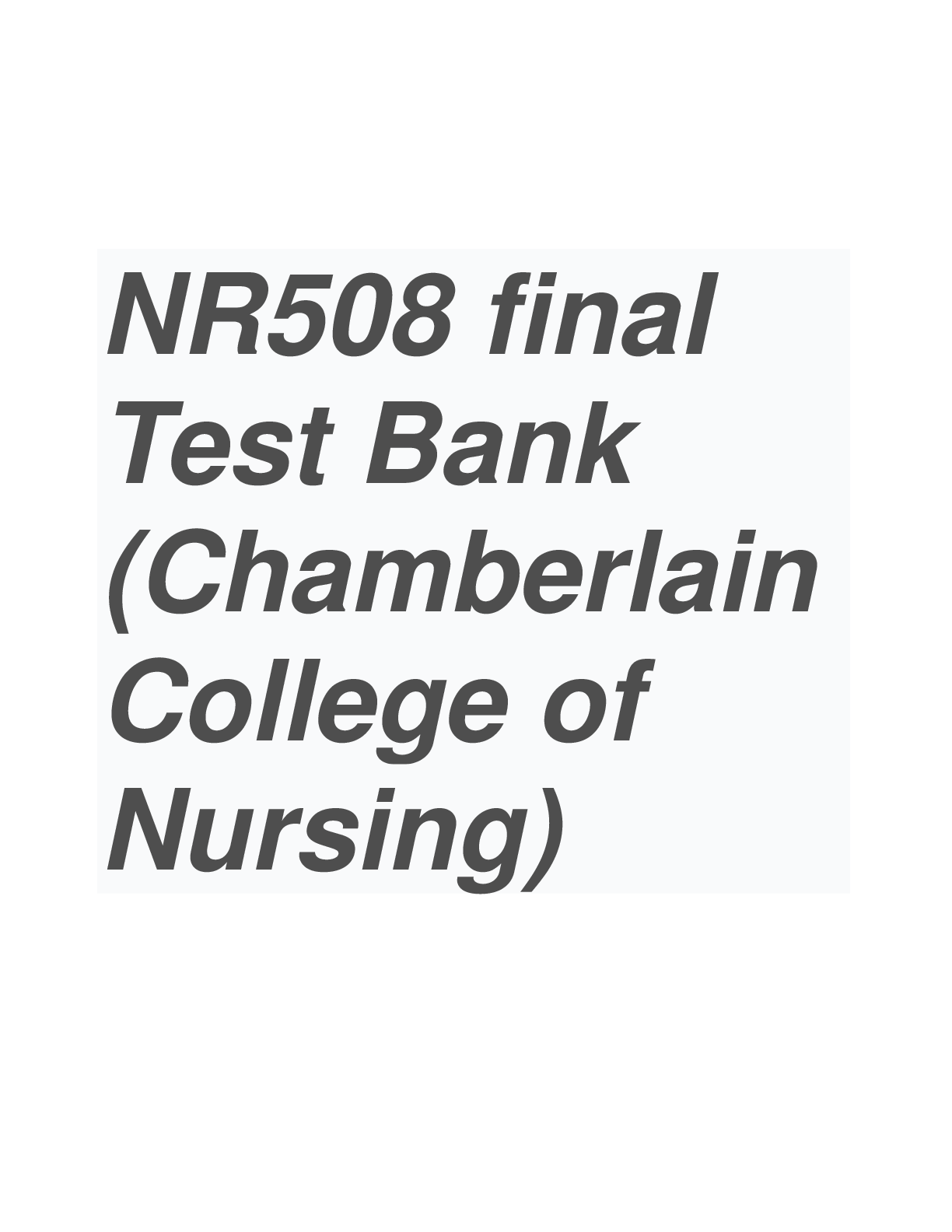
, 100% Correct, Download to Score A.png)
